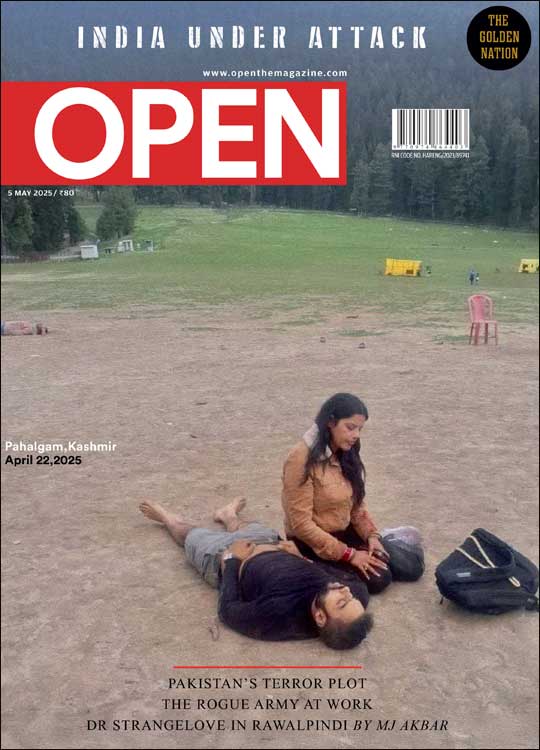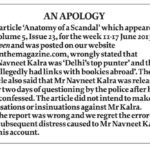Editor-in-Chief of Bihar
How an image-fixated chief minister has bent the state’s media to his will
 Dhirendra K Jha
Dhirendra K Jha
 Dhirendra K Jha
|
16 Apr, 2012
Dhirendra K Jha
|
16 Apr, 2012
/wp-content/uploads/2015/11/nitish-media.jpg)
How an image-fixated chief minister has bent the state’s media to his will
If you haven’t heard of an income tax raid on the residential premises of Nitish Kumar’s close aide and treasurer of the ruling Janata Dal-United (JD-U), Vinay Kumar Sinha, you are not alone. Thanks to the local media, it took a while even in Patna—where the house is located—for people to get to know. This, incidentally, is the same place where Nitish Kumar used to live until he became Chief Minister of Bihar. In the aforementioned raid, which took place in the third week of March, tax sleuths seized sacksful of cash, nearly Rs 5 crore of it, and ownership papers of 50 flats located in different parts of Patna, among other things. But in the next morning’s newspapers, this news was either missing or buried deep within as a single-column or brief item on an inside page.
“Not that it was not big news, it indeed was,” says the editor of an English daily in Bihar, “But, you see, that’s how it is.” The helplessness of this editor, who speaks anonymously, is a feeling shared by several other journalists. They talk ominously of controls placed on the media in Bihar. Yet, what is most striking about this awkward truth of the state is the determination with which this ‘control’ is being exercised on the media. It is a carrot-and-stick mechanism that is unparalleled in the modern history of Bihar.
“This is undeclared censorship,” says Dr Raihan Ghani, a veteran Urdu journalist of Patna. “I joined this profession in 1978, but I have never seen this kind of censorship before.” Dr Ghani is himself a victim of this censorship. As Chief Editor of a local Urdu daily, Pindar, he had been writing a front-page column, ‘Doh Tuk’, since March 2004. But in May 2007, one of his pieces enraged Nitish Kumar, and the paper’s proprietor had his column dropped, him demoted to Managing Editor, and his name removed from the print line. “In that column,” he says, “I had written against the misuse of religion for winning government favours. I had criticised a local Muslim religious leader, Syed Shah Shamimuddin Ahmed Monami of Khanqah Monamia, for reciting the Fatiha (opening words of The Quran) at the funeral of Manju Singh, the wife of Nitish Kumar. There is nothing wrong in a Muslim cleric reciting the Fatiha at the funeral of a Hindu. The only problem was that all other Muslim religious leaders had boycotted the funeral, as Nitish Kumar had turned it into a political event. I questioned Monami sahib because instead of demurring like other clerics, he chose to participate in such a politicised event of the JD-U and BJP, and that too, for obtaining some favour of the government.”
The response to that column spelt trouble for Dr Ghani. “The very next day,” he recounts, “I was called by the proprietor of my paper. He told me that the government was quite unhappy with me and that the state Minority Commission Chairman Naushad Ahmed wanted me ejected from my post. Soon, I was sidelined, my designation was changed from chief editor to managing editor, my name was replaced by that of the proprietor in the printline, and my column was stopped.” Frustrated, in February this year, Dr Ghani resigned. “If you are not ready to crawl, you won’t be able to get a job in [Bihar’s] Urdu press these days,” says he, now jobless, “The Urdu press has never been a good place to work, but under Nitish Kumar’s regime, it has become worse, and things are no better in the state’s Hindi press. I remember the Emergency, when there was declared censorship. Under Nitish, it is undeclared, and this makes it even more dangerous for democracy. The truth is being suppressed like never before, and the entire media is being pressured to build and burnish Nitish Kumar’s image.” Proprie- tor AK Ehsani has a different spin on the story. He says, “I had already decided to make him Managing Editor; it had nothing to do with the column.”
Why did the owner of Pindar act against Dr Ghani at the government’s behest? The answer is clear from information gathered via a series of RTI applications filed by Patna-based activists, Purandar Sawarnya and Shiv Prasad Rai. What emerges is an ugly game being played by Nitish Kumar in the distribution of government advertisements—being wielded as a tool of control.
According to the RTI responses, in 2006-07, Pindar got advertisements worth just about Rs 1 lakh from the state government. In 2007-08, after Dr Ghani was gagged at the start of that fiscal year, the paper was rewarded generously: its revenues from government ads soared to Rs 24 lakh. Nitish Kumar’s largesse apparently rose in step with the paper’s willingness to please him. In 2008-09, it drew nearly Rs 40 lakh from such ads, and in 2009-10, about Rs 48 lakh. Asked for his comments on this rise in the paper’s fortunes, Ehsani simply says: “I don’t believe these figures.” Still, discerning readers can perhaps attest that Pindar remains in no mood to lose its gains by rubbing the CM the wrong way.
That paper’s is not an isolated case in Bihar. Such pulls and tugs have attended other dailies as well. And in a state with so few private sector ads to go round, the government remains an outsized source of earnings for the media. Operating from such a position of strength, the Nitish Kumar government seems to be using its ad budget as a way to transform newspapers into courtiers.
It has also spelt a dramatic increase in government ad expenditure over that of the previous Rashtriya Janata Dal regime. In the first year after Nitish Kumar assumed chief ministership, the hike in allocations was not so glaring, but the years since have seen the state splurge on publicity. From Rs 4.5 crore in 2005-06 (the RJD ruled for most of this fiscal, losing power to the JD-U-BJP alliance in November 2005), Bihar’s ad expenses rose 20 per cent to Rs 5.4 crore in 2006-07, and then almost doubled to Rs 9.65 crore in 2007-08. If that wasn’t startling enough, the figured trebled to Rs 27.5 crore in 2008-09. The government was revelling in the joys of favourable newsprint, and the figure topped Rs 34.6 crore in 2009-10, before dipping a bit to Rs 28.5 crore in 2010-11. By this point, the message was presumably loud and clear, but the dip can be explained by the fact that an election code of conduct restrained adallotments for a few months in the runup to Assembly polls in November 2010.
Apart from expanding the Bihar government’s ad budget year after year, Nitish Kumar has centralised both the awarding of ads and release of payments—a decision notified in Bihar Gazette on 12 March 2008—thus reversing the earlier regime’s policy. This, many believe, was interpreted by media managements exactly as intended: that they had better fall in line.
How Nitish Kumar uses this ad lever to control the media is best illustrated by the case of Bihartimes.com. The media policy notified on 12 March 2008 also made internet sites eligible for government ads in Bihar. But Bihartimes.com, the state’s most visible news portal, is still in the queue for such ads while far less popular sites are crawling with them. As internet surfers can make out, it is being punished for continuing to carry reports related to corruption and misgovernance in the state.
“Bihartimes.com has been operational since 1999, and has been No 1 from the time of its inception. Many reputed journalists and intellectuals contribute to this news portal,” says its editor Ajay Kumar, “Immediately after the state government’s policy decision in March 2008, we applied for empanelment with the Public Relations Department (PRD). But we have not even been empanelled with the PRD so far. Nor has the PRD given any concrete reason for this.”
According to Ajay Kumar, other news portals that dare to exercise independence suffer the same fate. “Lesser known sites like Magnificentbihar.com get government ads in good numbers. Even Whispersinthecorridor, which is run from Bhopal and has hardly anything to do with Bihar, gets government ads from this state,” he says, “This only shows that unless you carry favourable stories on the Nitish Kumar government, you won’t even be empanelled for such advertisements.”
There are several specific instances that show how Nitish Kumar’s tool has been calibrated to suit his purposes. Just before the Assembly polls of November 2010, two leading Hindi dailies saw their government ads vanish. All they were guilty of was carrying reports judged as unfavourable to those in power. This, even as a senior journalist was hounded out of Bihar—by his own paper’s managers—for the temerity of writing against the government.
Small wonder that journalists in Patna often refer to Nitish as Bihar’s editor-in-chief instead of Chief Minister. The sarcasm is not unwarranted. Barring a few editors and media managers, just about every journalist concurs with Justice Markandey Katju, Chairman of the Press Council of India (PCI), when he points to a media crisis in the state. On 25 February, Justice Katju said: “The information I have gathered about the media in Bihar is not good… the press does not enjoy freedom at present… I have been told that people don’t muster the courage to write against the Bihar government or its officials. The Constitution is being violated by such people… You are a government, but you are not above the Constitution.”
Yet, when a three-member enquiry team of the PCI held hearings on the issue in Patna on 1-2 April, hardly any journalist turned up to make a deposition. Of the 100 odd people who did turn up and voice their complaints, according to sources, most were members of either civil society or a political party piqued by the slanted news they were being presented. Interestingly, a few journalists sent their testimonies in sealed envelopes to the PCI team, while some others spoke to it on the phone.
“We’ve completed hearings in Patna,” says Arun Kumar, a PCI member who was on the enquiry team, “In the weeks to come, we will hold similar hearings in Gaya, Bhagalpur, Muzaffarpur, Katihar and Monghyr. Then, we will hear the government’s argument, before finalising our report and submitting it to the PCI.”
Meanwhile, nobody wants to annoy the state’s editor-in-chief. And this means having to stifle the truth if it flies in the face of Brand Bihar, a miracle of development, as it is tom-tommed. The details of a tax raid on the ruling party’s treasurer, of course, does the brand no good, so why publish it?
The regime’s control mechanism has its share of apologists in the media too. The 27 March edition of Prabhat Khabar offers an example. In it, the Hindi daily’s Chief Editor Harivansha has a double-page article that purports to debunk Justice Katju’s remarks but can more sensibly be interpreted as unabashed glorification of the state government. ‘Suppose we believe that the press is not independent in Bihar, where are instances such as the Bhagalpur blindings, fodder scam or a genocide that did not find place in the local media?’ he writes (as translated from Hindi), ‘Or should we imagine news of a genocide, kidnapping or fodder scam even if they are not occurring, and only then would the press be considered free?’
Harivansha’s rhetoric, of course, is calculated to remind readers of some of Bihar’s most infamous injustices under past regimes. But the relevant point is the real state of affairs under the current government. According to the Bihar home department’s own annual report, the total number of cognisable offences—including rape, murder, robbery and kidnapping—registered in 2011 was 148,000. Now compare this with the figure for 2005, at the end of which Nitish Kumar attained power. In that year, the number of such offences stood at 104,000. That law-and-order has ‘returned’ to Bihar is just a myth.
Ironically, in the same edition of Prabhat Khabar, news of a gruesome crime was buried on page 13 as a small-single column item. It was news of the gangrape and murder of a woman at Jamui in front of her family members—who were made to run about in circles for over 12 hours before the police let them file a First Information Report (FIR).
Asked about this, Harivansh says, “We did not play the news item prominently because our correspondent at Jamui told us that the husband of the victim had a role in it. We, therefore, thought that giving prominence to that news would not have sent out a proper message. But we did carry regular follow-ups.” Asked why his paper’s ‘follow-ups’ did not care to report anything beyond the CM’s statement on the crime, he ducks the question. “That may be your viewpoint,” he says, “Nitish gets prominence because his stature is so large in Bihar.”
Of course, Prabhat Khabar was not alone in its dismissal of the appalling incident and attitude of the police. Many other dailies did the same. After all, Bihar has changed; won’t the report of a grisly murder and gangrape remind readers of Lalu Prasad’s RJD regime? And who wants to tarnish Brand Bihar?

/wp-content/uploads/2025/04/ToC-Cover-Pahalgam.jpg)











More Columns
Pahalgam Terror Attack: RSS chief invokes Ramayana, says Arjun must fight and slay Open
‘Terrorism Cannot be Tolerated’ Open
A Pope’s Funeral Lhendup G Bhutia